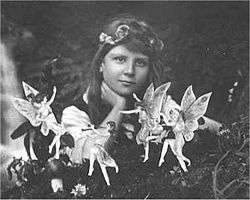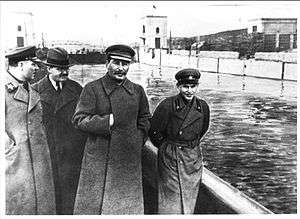Famous photographical manipulations
Photographical Manipulation is the alteration of a photograph.
The U.S. National Press Photographers Association (NPPA) Digital Manipulation Code of Ethics[1] states: “As journalists we believe the guiding principle of our profession is accuracy; therefore, we believe it is wrong to alter the content of a photograph in any way that deceives the public. As photojournalists, we have the responsibility to document society and to preserve its images as a matter of historical record. It is clear that the emerging electronic technologies provide new challenges to the integrity of photographic images... in light of this, we the National Press Photographers Association, reaffirm the basis of our ethics: Accurate representation is the benchmark of our profession. We believe photojournalistic guidelines for fair and accurate reporting should be the criteria for judging what may be done electronically to a photograph. Altering the editorial content... is a breach of the ethical standards recognized by the NPPA.”
Popular image manipulations throughout in history
Lincoln 1860
An iconic portrait of U.S. President Abraham Lincoln was a composite of Lincoln's head and the Southern politician John Calhoun's body.[2][3] This is a very good example of a photograph that is very well known by the general public as a real photograph and not an altered one.

Fairies 1917
This picture shows Frances Griffiths, one of two cousins who featured in the images known as the "Cottingley Fairies". This photo was part of a series showing fairies made by the cousins. The photos became highly publicized with some people believing they were fake while others believed their authenticity. Later the cousins admitted that the pictures were not manipulated but that they made the fairies out of cardboard and staged them in the scene. Besides this confession the cousins still claimed that they had seen fairies.


Purged 1930
Joseph Stalin often air-brushed his enemies out of photographs.[2] Nikolai Yezhov was removed from the original image after falling out of favor with Stalin and being executed.[2]
Mussolini 1942
Benito Mussolini had a portrait done of himself where he was on a horse, he had the horse handler removed from the original photograph in order to make himself look more heroic.[2]
Oprah 1989
Oprah Winfrey was on the cover of TV Guide in 1989.[4] The picture showed a very slender-looking Winfrey in a dress that was recognized by actress Ann-Margret's fashion designer.[4] It was revealed that the picture was actually a composite of Oprah's head spliced onto the body of Ann-Margret from a 1979 publicity shot.[4] Neither Oprah Winfrey nor Ann-Margret had given permission for the composite to be created.[4]
OJ Simpson 1994
OJ Simpson's June 17, 1994 mugshot was used on the cover of Time and Newsweek magazines. Newsweek used the mugshot unaltered whereas Time released one that made Simpson's face appear darker, blurrier and unshaven.[5] This resulted in many people crying foul at Time for attempting to make Simpson appear guilty when in America a man is considered innocent until proven guilty.[6]
Tourist of Death 1997
This picture was released to email and went viral after New York City was attacked on September 11, 2001. The title of the email was 'the tourist guy', 'the accidental tourist', 'Waldo' or the 'WTC Guy'. It showed a man standing on the observation deck of one of the World Trade Center towers before the plane hit the building. When others started claiming to be the subject of the photo a 25-year-old Hungarian man named Péter Guzli came forward and explained that he did not want any publicity.
"I'd like to keep my identity incognito.... This was a joke meant for my friends, not such a wide audience." Guzli had taken the picture in 1997 when he had visited relatives in New York, after 9/11 he edited the picture to make it look like he had been on the tower when the plane hit.
Diversity 2000
Hoping to illustrate its diverse enrollment, the University of Wisconsin at Madison doctored a photograph on a brochure cover by digitally inserting a black student in a crowd of white football fans. The original photograph of white fans was taken in 1993. The additional black student, senior Diallo Shabazz, was taken in 1994. University officials said that they spent the summer looking for pictures that would show the school’s diversity but could find none.
Walski forgery 2003
In the early media coverage of the 2003 Iraq War, a minor controversy erupted when it was revealed that Los Angeles Times photographer Brian Walski had taken two images and made a more dramatic composite.[7]
“When that guy came up with the baby, I shot off ten more frames. I had just one where you could see the soldier's face. The others he was turned away. I put four pictures on my laptop. I was going back and forth. There was no reason to do [what I did]. I was playing around a little bit. I said, 'that looks good.' I worked it and sent it.... I wasn't debating the ethics of it when I was doing it. I was looking for a better image. It was a 14 hour day and I was tired. It was probably ten at night. I was looking to make a picture. Why I chose this course is something I'll go over and over in my head for a long time. I certainly wasn't thinking of the ramifications”.
On April 1, Walski was fired.[7]
Beatles Abbey Road 2003
The original copy of the Beatles' Abbey Road album cover shows Paul McCartney, third in line, holding a cigarette. United States poster companies have airbrushed this image to remove the cigarette from McCartney’s hand. This change was made without the permission of either McCartney or Apple Records, which owns the rights to the image.
Kerry-Fonda Rally 2004
A manipulated photograph surfaced during the U.S presidential campaign of John Kerry in 2004, causing serious controversy.[8] The picture shows both Kerry and Jane Fonda speaking at an anti-war rally.[8] Kerry's team quickly responded that while he did attend many rallies throughout the 1970s, and he did attend at least one with Jane Fonda (a September 1970 anti-war rally in Valley Forge, Pennsylvania of which there is a picture of Fonda with Kerry in the background), Kerry and Fonda never spoke together at any rallies.[8]
Ralph Lauren 2009
The most notorious example of extreme retouching in fashion advertising was made in a magazine advertisement by Ralph Lauren which depicted a heavily manipulated photo of model Filippa Hamilton.[5] Many complaints were made saying that the image had impossibly inhuman proportions. A Ralph Lauren representative admitted to "poor imaging and retouching", and added, "we have learned that we are responsible for the poor imaging and retouching that resulted in a very distorted image of a woman’s body. We have addressed the problem and going forward will take every precaution to ensure that the calibre of our artwork represents our brand appropriately."[5]
See also
References
- ↑ "Digital Manipulation Code of Ethics".
- 1 2 3 4 "Tampered photos | PRI's The World". Pri.org. 2008-06-03. Retrieved 2013-04-15.
- ↑ "Photo Tampering throughout History". Fourandsix Technologies.
- 1 2 3 4 "TV Guide/Oprah/Ann-Margret - Pictures that lie (photos) - CNET News". News.cnet.com. 2011-05-05. Retrieved 2013-04-15.
- 1 2 3 "Picture-perfect manipulation". Nationalpost.com. Retrieved 2013-04-15.
- ↑ "Famous Pictures: The Magazine".
- 1 2 "Camera Works: Photo Essay". washingtonpost.com. Retrieved 2013-04-15.
- 1 2 3 Hafner, Katie (2004-03-11). "The Camera Never Lies, But the Software Can - New York Times". Nytimes.com. Retrieved 2013-04-15.